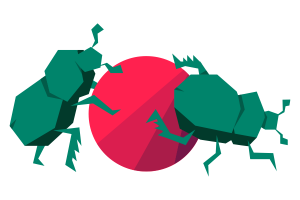Case Study
Dung Beetles
Nature’s indispensable recyclers
Partners Involved: Beetles, Animal Waste, Waste Disposal Organizations
Type of Partnership: Win-Win for Public and Planet
Partnership Models: Waste Manager, Nourisher
While the dung beetles are nourished with food, for the Public, they remove dung from sight, smell, and inadvertent footstep. For both Public and Planet benefit, the dung beetles bury whatever they do not immediately eat, adding fertilizing nitrogen to the soil, as opposed to losing it in the atmosphere.
Scientists have long appreciated dung beetles as nature’s indispensable recyclers. But the intricacies have only been discovered more recently. Researchers are learning that every dung pat is a complex microcosm unto itself. Entomologists have discovered that as many as 120 different species of dung beetles and tens of thousands of those species will converge on a single large pat of dung as soon as it is laid—making it disappear in a matter of hours or even minutes. One research team in Africa reported counting 16,000 beetles on a single elephant dung pat; when the scientists returned two hours later, the pat had disappeared.
Dung beetles are among humanity’s greatest benefactors. Not only do they remove dung from sight, smell and inadvertent footstep; by burying whatever they do not immediately eat, they add fertilizing nitrogen to the soil instead of losing it in the atmosphere.
SDGs Targeted: SDG 13 Climate Action & 15 SDG Life on Land
Links & Sources:
Case Study
Dung Beetles
Nature’s indispensable recyclers
Partners Involved: Beetles, Animal Waste, Waste Disposal Organizations
Type of Partnership: Win-Win for Public and Planet
Partnership Models: Waste Manager, Nourisher
While the dung beetles are nourished with food, for the Public, they remove dung from sight, smell, and inadvertent footstep. For both Public and Planet benefit, the dung beetles bury whatever they do not immediately eat, adding fertilizing nitrogen to the soil, as opposed to losing it in the atmosphere.
Scientists have long appreciated dung beetles as nature’s indispensable recyclers. But the intricacies have only been discovered more recently. Researchers are learning that every dung pat is a complex microcosm unto itself. Entomologists have discovered that as many as 120 different species of dung beetles and tens of thousands of those species will converge on a single large pat of dung as soon as it is laid—making it disappear in a matter of hours or even minutes. One research team in Africa reported counting 16,000 beetles on a single elephant dung pat; when the scientists returned two hours later, the pat had disappeared.
Dung beetles are among humanity’s greatest benefactors. Not only do they remove dung from sight, smell and inadvertent footstep; by burying whatever they do not immediately eat, they add fertilizing nitrogen to the soil instead of losing it in the atmosphere.
SDGs Targeted: SDG 13 Climate Action & 15 SDG Life on Land
Links & Sources:
